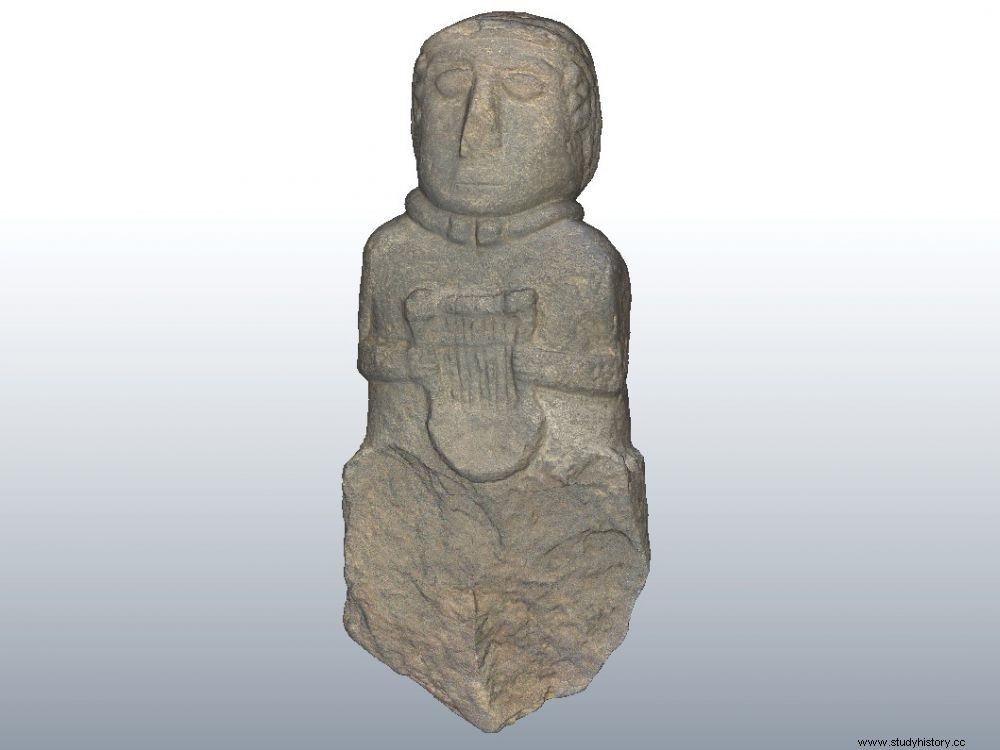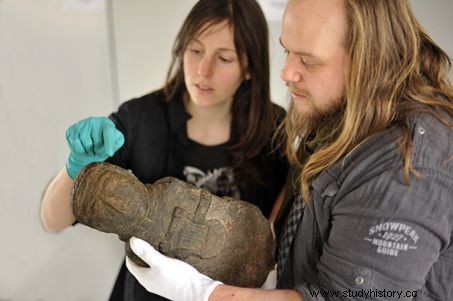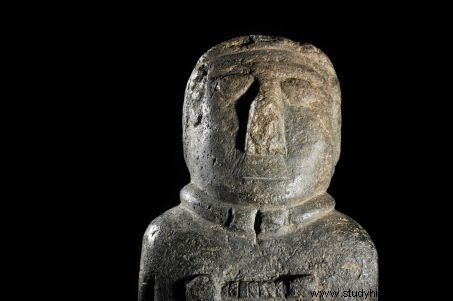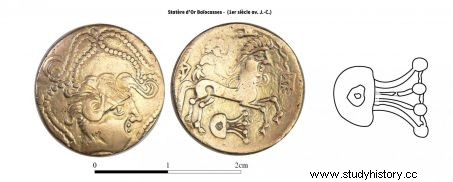The study of a unique sculpture from the Iron Age, found in Brittany, allows us to come back to a little explored area, Gallic musical instruments.

3D scan of the Gallic statue of the bard with the lyre (Brittany).
At the mere mention of the word bard, it is Assurancetourix that the unconscious of most of us delivers gagged and tied to its branch under a sky speckled with stars, while its merry companions from the village of Asterix revel in roasted wild boars... But if this forever misunderstood musician had a crush on his lyre, a study carried out on a rare Gallic statue has just delivered new details on this seven-stringed instrument.
 Bust of the bard with the lyre, found in the fortress of Paule, in the Côtes-d' Armor in 1988. ©Laureen Keravec
Bust of the bard with the lyre, found in the fortress of Paule, in the Côtes-d' Armor in 1988. ©Laureen Keravec
A team led by Julian Cuvilliez, from the Center for Research and Interpretation in Experimental Archeology (PRIAE) in Kerpert (Côtes-d'Armor) has digitized in 3D and carried out the photogrammetry of a stone sculpture representing a Gallic lyre player , a one-of-a-kind work. Helped by experts from the Technical Resource Center (CRT) in Morlaix, the specialists were able to unlock a few secrets of this 43 cm high work, carved in meta-hornblendite - one of the hardest granite stones in Brittany – and kept until then in a safe of the Regional Archeology Service (SRA) of Brittany in Rennes. This bust was discovered in 1988 in levels dated 1 st -2 e century before our era, in a ditch of the Celtic fortress of Paule (Côtes d'Armor).
 Julian Cuvilliez and Audrey Lecorgne, specialists in archaeo-musicology, manipulating the bust of the bard at the lyre , in the premises of the Regional Archeology Service (SRA) of Brittany. ©Laureen Keravec
Julian Cuvilliez and Audrey Lecorgne, specialists in archaeo-musicology, manipulating the bust of the bard at the lyre , in the premises of the Regional Archeology Service (SRA) of Brittany. ©Laureen Keravec
"His discovery brought a new perspective on the musical practice of the Gauls “, explains with passion Julian Cuvilliez to Sciences et Avenir . The figure, with a tonsured head and wearing a torc – a necklace known to have been worn by Celtic warriors of the Iron Age aristocracy – also holds his lyre upside down. "It has been speculated that it may be of a mortuary attribute" , continues Julian Cuvilliez, especially since the man, with his eyes closed, seems to be sleeping. 3D scans revealed that his nose was intentionally broken, with the edge of a stone chisel clearly identified.
"The likely consequence of an act of desacralization" , continues the specialist who explains that this voluntary mutilation of the statue, followed by its burial could have followed the replacement of the old Gallic aristocracy of the region by Gallo-Roman families pro-caesareans after the defeat of Alesia in 52 before JC. The man with the lyre was indeed found in the ancient territory of the Osismes ("the People of the end"), a people of Armorican Celts occupying the end of Finistère. Those who, according to Caesar in The Gallic Wars , had come to fight alongside Vercingetorix during the famous siege of Alesia.
 Close-up of Gallic statue of Bard with lyre (2nd-1st century BCE) . © Laureen Keravec
Close-up of Gallic statue of Bard with lyre (2nd-1st century BCE) . © Laureen Keravec
"The 3D examination of the lyre has above all made it possible to verify details of his bill. Thus, the U-shaped uprights of its asymmetrical body are overcome a square knob on one side and round on the other, unlike the contemporary lyres of the Mediterranean world" , announces Julian Cuvilliez. A variation that could perhaps symbolize the masculine and the feminine, connected by a horizontal yoke. To go even further in their investigations, the researchers carried out an experimental reconstruction of this Gallic lyre, under the same conditions and with the same tools, reforged for the occasion, that the craftsmen of the Iron Age used. Based on palynological data collected on Gallic sites, they also selected ash from among the woods then used in Armorica (oaks, willows, and maples). "This essence had both the mechanical and acoustic properties essential to the realization of a lyre, in addition to holding a special place in the religious life of the Gauls who used it on many occasions, at the 'like ex-votos'.
 Reconstruction of the Gallic lyre using tools identical to those of the age of iron. ©Laureen Keravec
Reconstruction of the Gallic lyre using tools identical to those of the age of iron. ©Laureen Keravec
Other projects are under study:the Irisa (Institute for Research in Computer Science and Random System), specialized in virtual and augmented reality, now wishes to bring back to life what could have been the music of the Age of Iron, through instruments recreated on tactile and virtual media. More certainly, and this is perhaps one of the other great successes of this operation, "pupils are currently learning to play the Celtic lyre in schools, from copies of the historic instrument "! A reward for Julian Cuvilliez... who is also a luthier and a musician!
 Gallic coins on which lyres were found. © Arnaud Desfonds (Inrap Bretagne-PRIAE)
Gallic coins on which lyres were found. © Arnaud Desfonds (Inrap Bretagne-PRIAE)
The origin of the lyre in Gaul remains a subject of questioning and, before the discovery of this statue in the fortress of Paule (Côtes-d'Armor), this attribute was totally unknown in Celtic statuary. Among the Greeks, it is to the god Apollo that mythology associates his creation. Historically, its existence could date back to the Bronze Age (3000-1000 BC), if we are to believe the decorations of Sopron vases unearthed in Hungary. The lyre would thus be one of the oldest musical instruments in Europe. And the oldest in Brittany, certainly. As for the lyre player, the ancient authors describe him explicitly. Diodorus of Sicily (90-30 BC), in his History , recounts as well as Celtic poets, bearing the name of bard (bardos ), "singed with lyre-like instruments ". Strabo (60 BC-20 AD), in his Geographica , evokes these "bards singers of hymns and poets" , and Ammian Marcellinus (330-400 A.D.) relates that "bards sang to the sweet strains of the lyre, composing heroic verses about the exploits of the bravest ". "Music was a medium for teaching, and for the transmission of stories" , explains Julian Cuvilliez of the Center for Research and Interpretation in Experimental Archeology (PRIAE) in Kerpert (Côtes-d'Armor). Bards, like later bards Greeks, the skaldes Scandinavians, or even today the griots, in West Africa, are storytellers, conveying from village to village, stories and epics.
